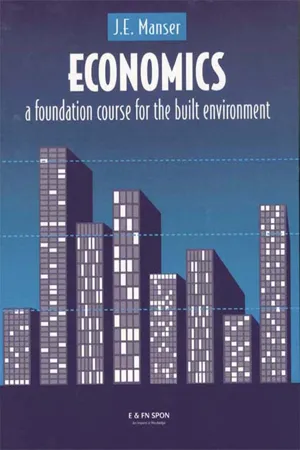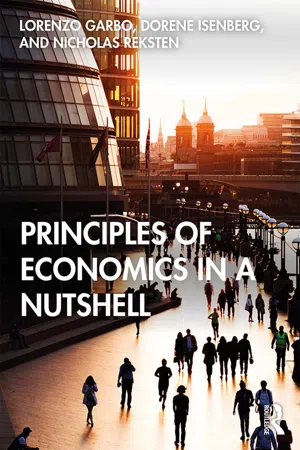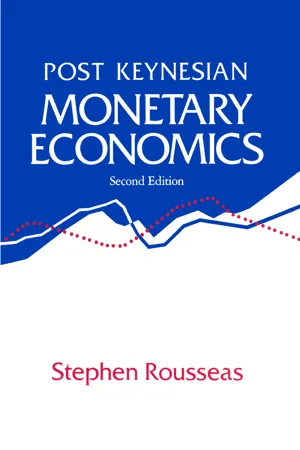Change in Money Supply
Change in money supply refers to the alteration in the total amount of money available in an economy. This can occur through various means, such as central bank policies, government interventions, or changes in banking practices. An increase in the money supply can lead to inflation, while a decrease can result in deflation, impacting the overall economic conditions.
7 Key excerpts on "Change in Money Supply"
- eBook - ePub
- W. Charles Sawyer, Richard L. Sprinkle(Authors)
- 2020(Publication Date)
- Routledge(Publisher)
...For an example of a more comprehensive definition of the money supply for the U.S., see any recent issue of theFederal Reserve Bulletin.3For those interested in a more detailed treatment of these relationships when the economy has currency drains, see Appendix 15.1.4A secondary market is where previously issued financial assets are bought and sold. This is distinct from a primary market, where newly issued financial assets are sold.5In the case of currency, this form of money earns no interest at all. In the case of an interest-bearing checking account, it does not earn as much interest income as one can earn on bonds or non-checkable deposits.6In most cases, real GDP would be a useful proxy for the real level of economic activity.7In more general terms, the central bank may adjust the rate of growth of the money supply that affects interest rates. It is rare for the money supply to actually decline for any extended period of time. Adecreasein the money supply is in most cases really a slowdown in the rate of growth of the money supply relative to the rate of growth in the demand for money.8We are consciously avoiding the issue of what the central bank’s target is. Whether or not the target is the interest rate or the money supply is not important in the current context. Changes in the money supply will affect interest rates and this in turn will have an effect on the exchange rate.9In simple terms,cash flowis total cash revenues minus total cash costs. In reality, the term is considerably more complex. For a more thorough treatment of cash flow, see Brigham and Gapenski (1997).10All interest rates and exchange rate changes are in per annum terms.11Appendix 15.2 presents a brief mathematical formulation of interest parity.12We have assumed that the inflation rate or the price level in the U.S. remains constant...
- eBook - ePub
Economics
A Foundation Course for the Built Environment
- J.E. Manser(Author)
- 2003(Publication Date)
- Routledge(Publisher)
...22 The money supply PREVIEW What is money? If everyone were paid twice as much money as they currently earn, how much better off would we all be? How does bank lending alter the money supply? How do interest rates influence the money supply? How does monetary policy affect the construction industry? THE VALUE OF MONEY In the 1970s unprecedented inflation came to be seen as the most urgent problem facing the government. Efforts to influence the growth of demand, in order to maintain full employment, gave way to policies aimed at slowing the rise in prices. Inflation reached 24% at its peak, which meant in just over three years the value of money would be halved. Concern about prices brought a renewed interest in the quantity theory of money, led by the American economist, Milton Friedman. In essence the quantity theory states that, other things being equal, putting more money into the economy will inflate prices. It offered the prospect of a simple, if painful, solution to the problem of rising prices. Because money circulates, any attempt to measure the volume of money must recognize there are two variables, the supply of money and the frequency with which it changes hands. Money is exchanged whenever goods (or services) are purchase The relationship between money, prices and the volume of goods can be expressed as MV = PT, where: M = money supply V = velocity of circulation P = the average price level T = number of transactions (volume of trade). This is no more than a truism: the money exchanged for goods and services must equal the value of the items purchased. If the equation is reformulated as: the policy implications become clearer. To restrict the rise in P we must prevent growth on the other side of the equation, which can be done by controlling MV. Assuming that V is constant, i.e...
- eBook - ePub
- Lorenzo Garbo, Dorene Isenberg, Nicholas Reksten(Authors)
- 2020(Publication Date)
- Routledge(Publisher)
...Each of these depends on the degree of liquidity, where degree of liquidity stands for acceptability as means of payment or ease of conversion to cash. To introduce the different aspects and definitions of the money supply, we start with the Monetary Base and then introduce the two additional categories. Beginning with the narrowest definition and proceeding according to decreasing liquidity, we have: MB Currency held in the vaults of financial institutions and reserves held by the Central Bank (the Federal Reserve, or Fed, in the US). M1 Currency held by the public + checkable deposits + travelers’ checks. M2 M1 + deposits for which the possibility of writing checks is more limited, such as saving accounts, time deposits (short maturity), and money market mutual fund shares. As said earlier, the most common definition of Money Supply is: M1, even though the Fed uses M2. The Federal Reserve (Federal Reserve, Tables H-3 and H-6) collects data on these categories and what follows should give you an idea of their respective magnitudes in the US. MB: $3,244.5 billion in May 2019; M1: $3,784.0 billion in May 2019; and M2: $14,632.8 billion in May 2019. 7.2 Money creation While you may have thought that money was created simply by being printed, there are actually several different and important institutions in the process of creating money. Central Banks – the Federal Reserve System (Fed) in the US, the Bank of England in the United Kingdom, the European Central Bank in the Euro Zone, and so on – are the only institutions authorized to issue their respective currency. So, the American currency, the US dollar, can be legally issued only by the Fed, as the euro can only be issued by the European Central Bank. But because currency is not the only component of money supply, commercial banks, such as Citibank or Bank of America, also play an essential role in the determination of the money supply of a country...
- eBook - ePub
- Rousseas(Author)
- 2016(Publication Date)
- Routledge(Publisher)
...CHAPTER 3 The demand for money and the rate of interest The exogenous money supply Within traditional Keynesian economics money serves as a means of payment and a store of wealth. These two functions of money were used by Keynes to undermine the classical dichotomy between the real and monetary sectors of the economy. The end result was his liquidity preference theory of the demand for money which allowed changes in the monetary sector to be transmitted to the real sector through changes in the rate of interest. But Keynes also assumed, along with everyone else, that the supply of money was exogenously determined. An exogenous money supply is simply another way of saying that the central bank (through its use of open market operations, the discount rate, and reserve requirements) can adjust the overall volume of money, in response to changes in the demand for it, to that level consistent with its policy objectives. In a tight money situation, neoclassical Keynesian analysis, as we shall see, did allow that certain short-run leakages could occur, via changes in the income velocity of money in response to interest-rate changes, that would tend to undermine the effectiveness of a monetary policy operating directly on the supply side. Such leakages, however, were believed to play themselves out quickly, allowing the full effectiveness of monetary policy to take hold in sufficient time to achieve the policy objectives of the monetary authorities. Monetarists, on the other hand, deny that the central bank can effectively use discretionary monetary policy in the short run. The variable lags of monetary policy, in conjunction with the inability of anyone to locate the actual position of the economy on the business cycle, at any particular moment of time, make it impossible, according to the monetarists, for the central bank to control the exogenous money supply in a contracyclical manner...
- eBook - ePub
- Milton Friedman(Author)
- 2017(Publication Date)
- Routledge(Publisher)
...When the money changes are large, they tend to dominate these other factors—or perhaps one might better say, they will force these factors to work in a particular direction. Thus there seems little doubt that a large change in the money supply within a relatively short period will force a change in the same direction in income and prices and, conversely, that a large change in income and prices in short periods—a substantial short-period inflation or deflation—is most unlikely to occur without a large Change in Money Supply. This is certainly the conclusion suggested by the evidence for the deep depression cycles and for sizable inflations. But when the money changes are moderate, the other factors come into their own. If we knew enough about them and about the detailed effects of monetary changes, we might be able to counter these other effects by monetary measures. But this is Utopian given our present level of knowledge. There are thus definite limits to the possibility of any fine control of the general level of prices by a fine adjustment of monetary change. III Changes in Prices and Changes in Output Over Longer Periods Over the cycle, prices and output tend to move together—both tend to rise during expansions and to fall during contractions. Both are part of the cyclical process and anything, including a monetary change, that promotes a vigorous expansion is likely to promote a vigorous rise in both and conversely. The preceding section implicitly assumes this connection. Over the longer period, the relation between price changes and output changes is much less clear and in the first section we took the behavior of output for granted. Now this seems clearly valid, not only as an expository device but also as a first approximation to reality...
- eBook - ePub
Contemporary Economics
An Applications Approach
- Robert Carbaugh(Author)
- 2016(Publication Date)
- Routledge(Publisher)
...M1 is expressed by the following formula: M1 = Currency in the hands of the public + Demand deposits + Other checkable deposits + Traveler’s checks In our definition of money, we include currency only if it is in the hands of the public. Some cash is kept in bank vaults and is released only when customers withdraw cash from their vaults. Other cash is kept on deposit at a Federal Reserve Bank, which stores the funds for future use. Until this cash is released by banks or a Federal Reserve Bank, it is not considered part of the money supply. Notice that the components of M1 are highly liquid (immediately spendable) money that can be used to finance transactions. Coins and paper currency are as liquid as money can be. Checking accounts? Banks are legally obligated to make the money in your checking account available to you upon demand. Traveler’s checks, too, are immediately spendable money that we widely accept as payment for goods and services. 4 4 Economists use a broader measure of the money supply to account for other financial assets. The M2 measure of the money supply includes all of the components of M1 as well as (small-denomination) time deposits, money market deposit accounts, and money market mutual funds. As seen in Table 14.3, the M1 money supply equaled $3,049.4 billion in 2015. Of this amount, 43 percent was issued by the U.S. Treasury and the Federal Reserve Banks as coins and paper currency; 57 percent was issued by our banking system as checking account money (demand deposits and other checkable deposits), and zero percent came from traveler’s checks. Put simply, checking accounts are a significant component of the M1 money supply. Why are checking accounts a widely used type of money? First, making large payments by check is convenient. Imagine how much paper money—say, $20 bills—you would need to purchase a new house! Second, checks provide a record of payment, thus making it unnecessary to keep receipts for purchases of goods and services...
- eBook - ePub
Foundations of Macroeconomics
Its Theory and Policy
- Frederick S. Brooman(Author)
- 2017(Publication Date)
- Routledge(Publisher)
...As long as this supply is exactly sufficient to satisfy the demand for it, the behavior of the monetary side of the economy will be compatible with the equilibrium of aggregate supply and demand described in Chapter 10. However, an excess or shortfall of the demand for money against the supply of it is likely to upset any previously existing equilibrium in the rest of the economy, while disturbances in the markets for commodities and labor will themselves upset the balance on the monetary side. What, then, determines the demand for money? To answer this question, it will be convenient to distinguish between the demand for it as a means of payment and the demand for it as a liquid asset (this is, of course, a highly artificial distinction, extremely difficult if not impossible to apply in practice, but it is adopted here merely as an expository device). 2. The Transactions Demand for Money Until the period between World Wars I and II, most economists paid little attention to the demand for money as an asset on the ground that rational individuals would hold only the amounts they needed to make current payments. Since money does not yield interest, an individual who found himself with more of it than he needed for payments purposes would use the surplus to acquire income-yielding assets such as bonds, stocks or real estate; he might even increase his consumption rather than continue to hold a “barren” asset. Consequently, it was argued, the usual effect of an increase in the supply of money would be to raise the level of prices, since the additional money would be financing an increase in the demand for goods and services. Conversely, a reduction in the money supply would cause people’s holdings to fall below the level needed for payments, and their efforts to restore their money balances by selling other things would force the price level down...






